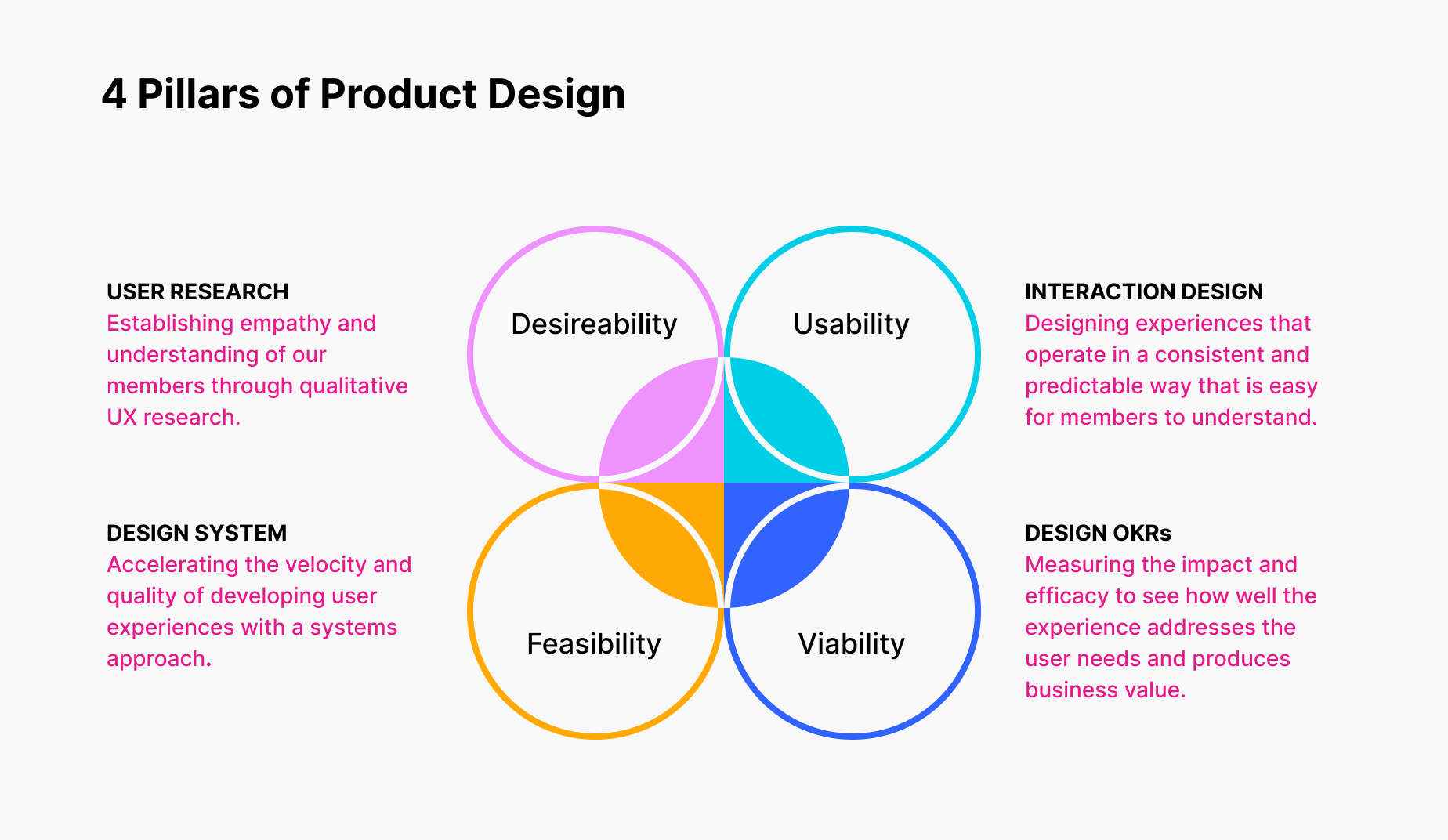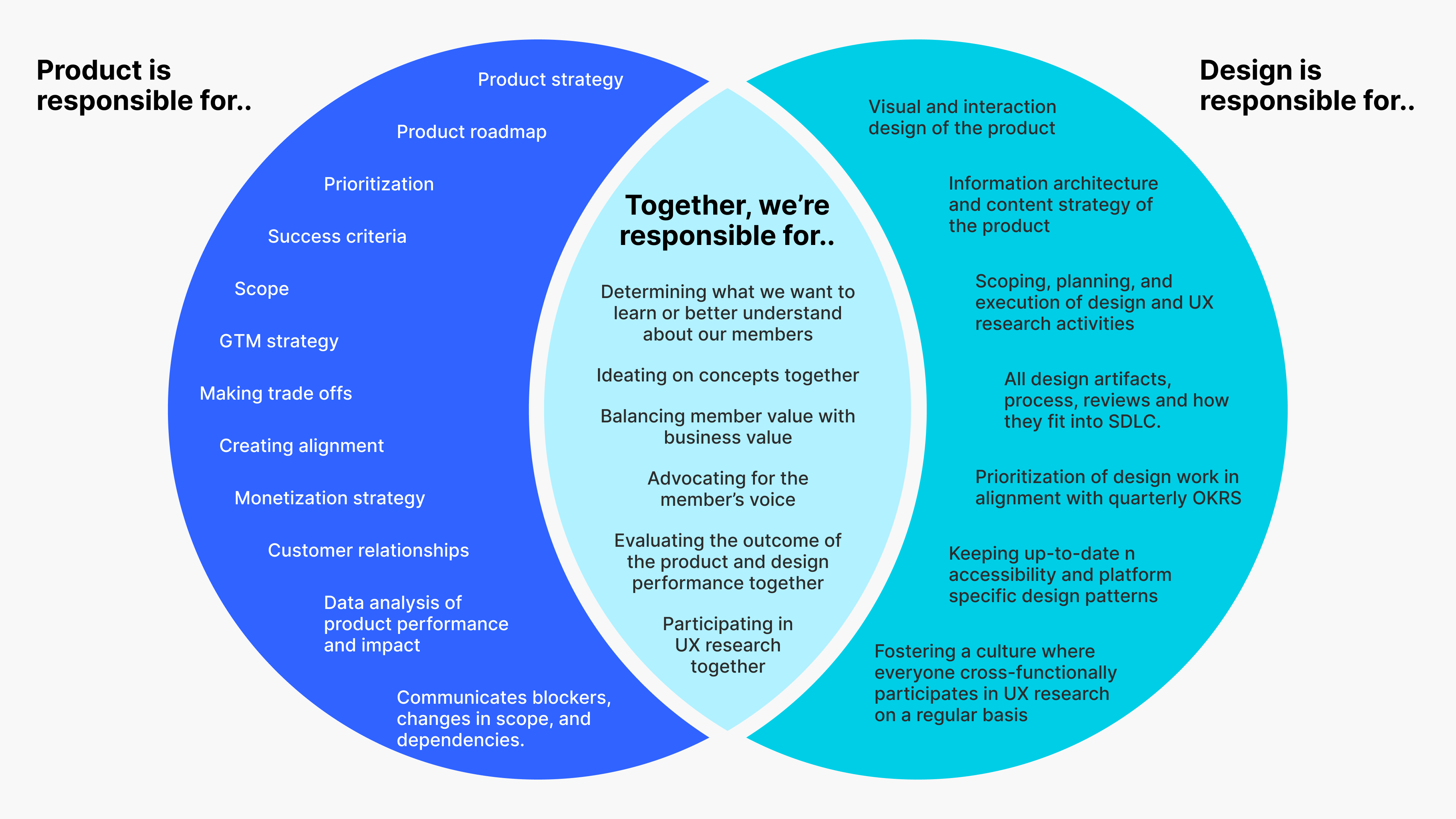Product managers and designers are neighbors at our foundation
When I was a sophomore in high school, we moved into a new neighborhood after my family bought our first single-family home. The driveway was large enough to play half-court basketball, and the bouncing of my basketball rang like an alarm in the neighborhood: there was a new kid on the block.
Some neighbors welcomed us with plates of freshly baked cookies and smiles equally as warm. Others were more casual with a friendly wave or an impromptu driveway conversation. The dynamics had changed as our neighbors made space and accepted us as a part of the community, each in their own unique way.
The plots of land and fences gave each of our homes a clear and distinct demarcation of what we owned. There was an unspoken agreement amongst neighbors to maintain our respective homes to a consistent baseline standard. Shared values of respect, curiosity, and empathy for each other allowed us to build relationships that fostered a reciprocal exchange of value and support, while respecting ownership. The relationship between product management and product design is akin to this concept of neighbors.
Design’s role in the product organization
As DISQO continues its rapid growth in building a customer experience platform that connects what people think and do across brand experiences and consumer journeys, our product team has also grown and evolved. Most recently we introduced a product design team to our consumer product organization. While the team is new to DISQO, it is not a new or foreign concept within the tech industry. We’re building an embedded product design team within the product organization to renew our focus on building value for our member base through an innovative mindset centered on the user. This is a core strategy in stewarding the excellence of our products with a view to product-led growth.
Like the homes with clearly defined plots of land, the roles and responsibilities shared across product and design require definition to cultivate a neighborly relationship. The Venn diagram below (Fig.2 - Pillars of Product Design) was created by the DISQO team to establish a common, shared understanding of the roles and responsibilities across product management and product design.
When we introduced product design into our product organization, it didn’t just acquire responsibilities from product management; instead, design now shares responsibilities with our product, engineering, and growth teams (Fig.1 - Design and Product Org). After all, product design is a profession that goes far beyond designing the user interface.
Design is recognized by the organization as more than a skill or activity in the product organization. Instead, it’s seen as a profession that is focused on advocating for the user’s experience, which does several things. It augments engineering’s ability to execute designs with a design system, aligning content and messaging across the product with the user’s journey. Design also enables the product organization to navigate the fuzzy front-end of product and customer discovery work.
Click on the image to enlarge. The image opens in a new tab.
 Fig.1 - Design in the Product Org
Fig.1 - Design in the Product Org
What is product design?
Before we proceed further, it’s essential to establish how we define product design. Product design is the profession focused on creating products and experiences that solve users’ needs or pain points to improve usability and desirability.
The user-centered product design process consists of five stages:
- Discover. This stage begins with identifying and establishing empathy for the user through qualitative and quantitative UX research.
- Define. During this stage, the problem statement and hypothesis is defined, which sets the stage for the problem or core need to be addressed.
- Design. This stage is where the process enters the solution space when concept ideation occurs.
- Test. During this stage, the concepts are tested not just for the usability of the interaction design, but more holistically, to determine if the solution effectively meets the user’s needs.
- Develop. In the final stage of the product design process, an approved design is groomed, prepared, and documented to be prepped for development. Once this stage is complete, the product design team continues to support the initiative by testing builds, providing feedback to the development team, and after launch, tracking the performance of the experience and the impact on users.
The process of product design holistically impacts the desirability, usability, feasibility, and viability of an experience, as illustrated in the diagram below.
Click on the image to enlarge. The image opens in a new tab.
 Fig.2 - Pillars of Product Design
Fig.2 - Pillars of Product Design
Product design is a team sport; no part of this process can be done in a vacuum. Strong cross-functional collaboration throughout the product design process results in the best product experiences for our users.
Defining the product design role
Defining the product designer’s role and responsibilities is crucial because it can:
- Foster more meaningful engagement and interaction across functions
- Mitigate conflicts that arise from ambiguity or misunderstanding of who provides what and when
- Clearly define whom to go to for what and when
- Allow for each role to operate with greater focus
- Provide both designers and managers with the ability to take ownership and a stake in what goes out in the final product
- Allow both product designers and managers to evaluate the outcome together, leveraging their unique insight
Design is responsible for:
- Determining visual and interaction design of the product
- Developing the information architecture and content strategy of the product
- Prioritizing design work in alignment with quarterly OKRs
- Scoping, planning, and executing design and UX research activities
- Managing all design artifacts, processes, reviews, and how they fit into the software development lifecycle
- Measuring the usability and viability of the product experience
- Keeping up-to-date on accessibility and platform-specific design standards
- Fostering a culture where everyone across functions participates in UX research on a regular basis
Shared responsibilities across product and design
The responsibilities that product and design teams share shape the way the teams collaborate from discovery to development.
- Determining what we want to learn or better understand about the users
- Ideating on concepts together
- Balancing user value with business value
- Advocating for the user’s voice
- Evaluating the outcome of the product and design performance together
- Participating in UX research together
- Leveraging feedback across functions into performance evaluation of the respective teams
Defining the product management role
Finally, defining the responsibilities unique to product management helps designers understand what they can expect from the product managers they work with. It also helps to provide a definition of the wide landscape product management covers.
Product is responsible for:
- Product strategy
- Product roadmap
- Prioritization
- Success criteria
- Scope
- Go-to-market strategy
- Making trade-offs
- Creating alignment
- Monetization strategy
- Customer relationships
- Data analysis of product performance and impact
- Communicates blockers, changes in scope, and dependencies
Visualizing the roles and responsibilities together
Bringing the roles and responsibilities together into a holistic view helps us to better visualize how each role operates uniquely across the software development lifecycle, but more importantly, how much product and design share.
| Product |
Shared |
Design |
| Developing the product strategy |
Determining what we want to learn or better understand about our members |
Determining visual and interaction design of the product |
| Developing and maintaining the product roadmap |
Ideating on concepts together |
Developing the information architecture and content strategy of the product |
| Prioritizing work |
Balancing member value with business value |
Scoping, planning, and executing design and UX research activities |
| Developing success criteria |
Advocating for the member's voice |
Managing all design artifacts, processes, reviews, and how they fit into the SLDC |
| Data analysis of product performance and impact |
Evaluating the outcome of the product and design performance together |
Measuring the usability and viability of the product experience. |
| Managing the go-to-market strategy |
Participating in UX research together |
Keeping up-to-date on accessibility and platform-specific design standards |
| Determining what trade-offs to make |
Leveraging feedback across functions into performance evaluation of our respective teams |
Fostering a culture where everyone across functions participates in UX research on a regular basis |
| Creating alignment |
Maintaining an open line of communication about priorities and scope |
Prioritizing design work in alignment with quarterly OKRs |
| Monetization strategy |
|
|
| Customer relationships |
|
|
| Setting the project scope |
|
|
| Communicating blockers, changes in scope, and dependencies |
|
|
Click on the image to enlarge. The image opens in a new tab.
 Fig.3 - Product Management & Product Design Responsibilities
Fig.3 - Product Management & Product Design Responsibilities
How we crafted our new teams together
To develop a new and cohesive approach, leadership across product and design teams came together with their mental models of the roles and responsibilities for both roles. We created a psychologically safe environment and actively listened to each other’s perspectives, focusing on the priorities shared for the product and design roles.
It took a series of meetings to move our mindsets from defining activities and outputs to responsibilities, but with each iteration, we dug deeper into our foundational understanding.
Because the founders at DISQO are invested in operating with a user-centric mindset and value focus, transparency, and reducing dependencies across teams and domains, we were positioned for success.
Embedding product design into our core product organization is our investment and is fast becoming our advantage in driving greater value for our Survey Junkie members across our consumer product experiences. This will enhance the value we create for our members and will be a principal driver in growing member acquisition and retention with a product-led growth strategy.